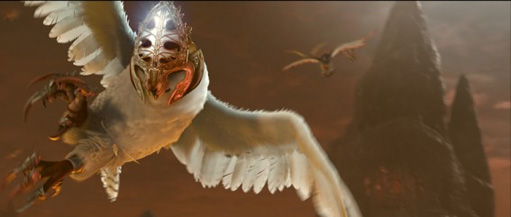Top 10 Film Industry Stories of 2010: #8
Simply Putting 3D in the Title Isn't Enough
By David Mumpower
January 27, 2011
As everyone made the same turn to 3D along with the lucrative 3D movie tickets that came with it, not enough people bothered to ask whether they were making a distinct enough product to differentiate themselves in the marketplace. The end result is the same as what we witness with every other part of the economy. The strong feast while the weak absorb unwarranted Internet cheap shots (my apologies to the true believers who made Alpha and Omega 3D).
In 2010, this meant that while Toy Story 3 and Alice in Wonderland became the top two movies of the year, becoming the sixth and seventh movies to gross a billion dollars in global revenue, several 3D releases never attained notice. To wit, Piranha 3D earned $25 million domestically, Step Up 3D earned $42.3 million (down over $15 million from the second Step Up title), and Legend of the Guardians: The Owls of Ga'Hoole 3D earned only $55.7 million against a $100 million production budget. Alpha and Omega’s $25.1 million domestic take against a $20 million production budget isn’t looking quite so bad now, is it?
Even sequels to established properties were not above the fray. Saw 3D behaved similarly to Step Up 3D, failing to match the box office of almost all previous titles in the franchise in spite of the higher ticket pricing that comes with a 3D release. Shrek Forever After is not included in the discussion of summer 2010 box office disappointments, but let’s be realistic here. Shrek the Third earned $322.7 million; its follow-up managed only $238.7 million domestically. In terms of global take, there is only a $50 million gap between the two films, which is why it was deemed neither a success nor a total flop. Relative to domestic take, though, the fourth Shrek film had less than 75% of the box office of its immediate predecessor in spite of inflated ticket pricing.
The other two titles listed above, My Soul to Take and Gulliver’s Travels, are small scale and large scale demonstrations of the potential trappings of thoughtless 3D productions. The horror film shot for $25 million couldn’t even tally $15 million domestically, a far cry from a similarly themed title from the previous year, Drag Me to Hell. Wes Craven is no Sam Raimi at the box office, but the difference should never be that dramatic for their horror flicks. And Gulliver’s Travels is simply cringe inducing when we run the numbers. A movie that cost $112 million to produce has earned barely $40 million domestically and is almost out of theaters. Yes, it has crossed $100 million abroad, but that’s not nearly enough to put it in the black.
What happened to these films? That is the logical question. The answer is that there can be too much of a good thing, and that presupposes that the existence of 3D IS a good thing. From the introduction of Chicken Little into the marketplace until the release of Avatar at the end of 2009, a total of 25 major digital 3D releases were released. In calendar 2010 alone, 23 3D titles received distribution, 24 if we count the re-release of Avatar itself. In that same time frame, the average price of a movie ticket increased from $6.41 to $7.85. And let’s be honest about the fact that you would be hard pressed to find a theater that will sell you a ticket in digital 3D for $7.85. At my local theater, the cost is about $13.50 and if you’re in an even larger metropolitan area, you are probably paying $3-$5 more than that.
Continued:
1
2
3




